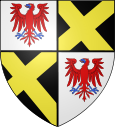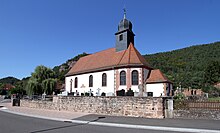Obersteinbach (Bas-Rhin)
| Obersteinbach | ||
|---|---|---|

|
|
|
| region | Grand Est | |
| Department | Bas-Rhin | |
| Arrondissement | Haguenau-Wissembourg | |
| Canton | Reichshoffen | |
| Community association | Sauer-Pechelbronn | |
| Coordinates | 49 ° 2 ′ N , 7 ° 41 ′ E | |
| height | 234-430 m | |
| surface | 9.18 km 2 | |
| Residents | 227 (January 1, 2017) | |
| Population density | 25 inhabitants / km 2 | |
| Post Code | 67510 | |
| INSEE code | 67353 | |
 Obersteinbach from the northwest |
||
Obersteinbach is a French commune with 227 inhabitants (as of January 1, 2017) in the canton of Reichshoffen in the Bas-Rhin department in the Grand Est region (until 2015 Alsace ). It is part of the Northern Vosges Nature Park .
geography
Obersteinbach is located on the northern edge of Alsace, about five kilometers east of the border with Lorraine in the valley of the Steinbach, a tributary of the Sauer , and surrounded by forests and red sandstone cliffs in the Northern Vosges ( Forêt Domaniale de Steinbach ). This landscape formation forms a unit with the southern Palatinate Forest on the German side and is also called Wasgau .
Obersteinbach is a street village that stretches along the Chaussee with its half-timbered houses.
history
middle Ages
The village of Obersteinbach was in the Lemberg office of the County of Zweibrücken-Bitsch and there in the Obersteinbach official school of the same name . The Frauener Hof and Fischbach belonged to the village of Obersteinbach . Both belonged together to the respective sovereign of the Lemberg office and the Bishop of Speyer .
Early modern age
Count Jakob von Zweibrücken-Bitsch (* 1510; † 1570) died in 1570 as the last male member of his family. The Lemberg office was inherited by his daughter, Ludovica Margaretha von Zweibrücken-Bitsch , who was married to the (heir) Count Philipp (V) von Hanau-Lichtenberg . Her father-in-law, Count Philipp IV. Von Hanau-Lichtenberg , gave the strict Roman Catholic Duke Karl III by immediately introducing the Lutheran creed . of Lorraine, the opportunity to intervene militarily, as the latter had suzerainty over the Bitsch rule, which was also part of the inheritance . In July 1572 Lorraine troops occupied the county. Since Philip IV was unable to cope with the overwhelming power of Lorraine, he chose the legal route. In the subsequent process before the Reich Chamber of Commerce, Lorraine was able to prevail with regard to the Bitsch rule, while the Lemberg office - and thus Obersteinbach as well - was awarded to the County of Hanau-Lichtenberg . The contract that ended the dispute also contained a passage that guaranteed the Catholics the freedom to practice their faith in Obersteinbach.
1736 died with Count Johann Reinhard III. the last male representative of the Hanau family. Due to the marriage of his only daughter, Charlotte (* 1700; † 1726), with the Hereditary Prince Ludwig (VIII.) (* 1691; † 1768) of Hesse-Darmstadt , the county of Hanau-Lichtenberg fell there.
Modern times
In the course of the French Revolution , the left bank of the Hanau-Lichtenberg county - and with it the Lemberg and Obersteinbach offices - fell to France in 1794. When the boundary was drawn in the Second Peace of Paris in 1815, it belonged to the Kingdom of Bavaria and there to the Rhine district . The demarcation of the border was problematic for France, as the route between the French fortresses Bitsch and Weißenburg led through Bavarian territory. In the border convention between Bavaria and France , Bavaria ceded Niedersteinbach and Obersteinbach to France in 1825 .
Population development
| year | 1962 | 1968 | 1975 | 1982 | 1990 | 1999 | 2007 | 2017 |
| Residents | 193 | 230 | 189 | 197 | 199 | 184 | 224 | 227 |
Culture and sights
- Numerous rock castles carved into the sandstone surround Obersteinbach. The most important of these is the Wasigenstein in the north from the beginning of the 12th century . This castle is the scene of the Walthari song . Not far from there are so-called sacrificial bowls directly on the German border on the Maimont , which from today's perspective are, however, the result of natural weathering. The ruins of Lützelhardt Castle to the west of the town also date from the 12th century . The Klein-Arnsberg castle ruins are a little younger .
- The Roman Catholic parish church of St. Martin dates from 1804 (dating above the lintel). A previous building (occupied since 1371) was destroyed in the course of the French Revolution in 1789. The current building stands on a cross-shaped floor plan with arched windows, oculi in the gable field and a slate-covered onion dome .
- The Protestant church stands on a rectangular floor plan and has segmented arched windows, a half-timbered east gable and a bell tower with a pointed helmet. It was founded in 1787 under Landgrave Ludwig IX. (Hessen-Darmstadt) . His monogram is emblazoned above the lintel.
- Museum of the history of the castles in the Steinbachtal.
Leisure and Tourism
The Vosges Club has marked many hiking trails in the area, which also lead to all the castle ruins and picturesque rocks. There are places to stop for refreshments and overnight stays in Obersteinbach.
traffic
The place is on the Départementstraße D3, the D35 coming from Bitche , runs parallel to the Franco-German border in west-east direction to Wissembourg.
literature
- Friedrich Knöpp: Territorial holdings of the County of Hanau-Lichtenberg in Hesse-Darmstadt . [typewritten] Darmstadt 1962. [Available in the Hessisches Staatsarchiv Darmstadt , signature: N 282/6].
- Alfred Matt: Bailliages, prévôté et fiefs ayant fait partie de la Seigneurie de Lichtenberg, du Comté de Hanau-Lichtenberg, du Landgraviat de Hesse-Darmstadt . In: Société d'Histoire et d'Archaeologie de Saverne et Environs (Eds.): Cinquième centenaire de la création du Comté de Hanau-Lichtenberg 1480 - 1980 = Pays d'Alsace 111/112 (2, 3/1980), p 7-9.
- Le Patrimoine des Communes du Bas-Rhin. Flohic Editions, Volume 2, Charenton-le-Pont 1999, ISBN 2-84234-055-8 , pp. 1585-1586.



